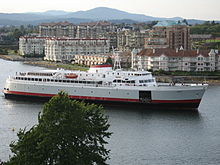
The Puget Sound Navigation Company (PSNC) was founded by Charles E. Peabody in 1898. Today the company operates an international passenger and vehicle ferry service between Port Angeles, Washington, United States and Victoria, British Columbia, Canada on the MV Coho, through its operating company, Black Ball Ferry Line.
History





In the past, the company operated an entire fleet of steamboats and ferries on Puget Sound in Washington and the Georgia Strait in British Columbia. Known colloquially as the Black Ball Line, the PSNC achieved a "virtual monopoly" on cross-sound traffic in the 1930s and competed with the Canadian Pacific Railway's steamships on several routes.
The company's trade name was inspired by the Black Ball Line which began scheduled passenger and freight service in 1818 with four sailing ships between New York and Liverpool. In 1884, the grandson of one of the founders, Charles Peabody, moved to Port Townsend Washington. Under modified Black Ball flag, he began the Alaska Steamship Company.
Before 1927, when the company was controlled by Joshua Green, the house flag consisted of a design by Mrs. Green, a red star on a white diamond on a blue background. After 1927, when Joshua Green sold his interest to the Peabody family, the Black Ball company flag was transferred over to Puget Sound Navigation Co., and the company became known as the Black Ball Line.
PSNC began to struggle following World War II, as operating costs increased. PSNC petitioned the State Utilities Commission for permission to raise its fares, but was rebuffed. Following a long series of court battles, PSNC's unionized employees finally called a strike. The company responded not by hiring strike breakers, but by halting operations, hoping public pressure would convince the State to permit a fare increase. The State declined to intervene, and PSNC eventually sold its domestic operations assets to the state of Washington's Department of Transportation for the sum of $4.9 million in early 1951, creating Washington State Ferries on May 31.
PSNC retained the assets used in their Canadian operations and, after the 1951 downsizing, operated a much-reduced fleet of five ships as Black Ball Ferries, Ltd. on routes between Vancouver and Nanaimo, and across Howe Sound and Jervis Inlet. The first all-Canadian route began on August 11, 1951 and was between Horseshoe Bay (in West Vancouver) and Gibsons Landing on BC's Sunshine Coast. In November 1961, this company sold most of its assets to BC Ferries, which had commenced operations in June 1960 as a division of the British Columbia Toll Highways and Bridges Authority, a Crown corporation of the British Columbia provincial government.
The current descendant of the Black Ball Line is Black Ball Ferry Line, which currently operates only one route across the Strait of Juan de Fuca, between Port Angeles and Victoria, using the MV Coho, built in 1959.
Originally Black Ball Line had a second service known as Black Ball Freight Service which was a subsidiary of the Puget Sound Navigation. It is unclear when the subsidiary was created. In 1936 R.J. Acheson purchased the subsidiary. In 1952, Acheson and his wife organized a new subsidiary of Black Ball Freight Service, naming it Black Ball Transport, Inc. By 2008 Black Ball Transport was renamed to its current name. Black Ball Freight Service ended in 2008.
Acquisitions
Neah Bay Dock Company
The Neah Bay Dock Company was a subsidiary of the Puget Sound Navigation Company. In 1929 the Neah Bay Dock company owned a wharf and a hotel in Neah Bay, Washington.
See also
References
- Stein, Alan J. (2001). Safe Passage The Birth of Washington State Ferries Seattle: Sodexho-Marriott Corp. ISBN 0-9664745-1-1., p. 9
- Ryan Hook (Nov 8, 2021). "The MV Coho ferry made its return to the Victoria's inner harbour this morning". Victoria Buzz.
- ^ Alan J. Stein (June 1, 2001). "The Sound and the Ferry: The Birth of Washington State Ferries". HistoryLink. Retrieved 2007-12-25.
- ^ 1818-2018: 200 years of Black Ball History, Black Ball Ferry Line, 2018
- Newell, Gordon R., ed., H.W. McCurdy Marine History of the Pacific Northwest, at 87, n.2, Superior Publishing, Seattle, WA 1966 ISBN 0-87564-220-9
- "Washington State Ferries History/Creation of WSF". Washington State Department of Transportation. Archived from the original on 2012-10-12. Retrieved 2007-05-14.
- Alan J. Stein (January 20, 2003). "Washington State Ferries begins operations on June 1, 1951". HistoryLink. Retrieved 2007-12-25.
- "Black Ball Ferries 1951-1961". Gary Little. Retrieved 2011-08-11.
- "BC Ferries: Our History". BC Ferries. Retrieved 2018-08-20.
- "History of Black Ball Ferry Line". Black Ball Ferry Line. Retrieved 2018-08-20.
- Kline and Bayless, Ferryboats – A Legend on Puget Sound, at page182.
External links
- [REDACTED] Media related to Puget Sound Navigation Company at Wikimedia Commons
- Official website
- Guide to the Vernon R. Stedman Papers. 1933-1972. 1.21 cubic feet (2 boxes).
48°24′9.12″N 123°23′59.39″W / 48.4025333°N 123.3998306°W / 48.4025333; -123.3998306
| Puget Sound Navigation Company | |
|---|---|
| Ships and date acquired |
|
| Officers and personnel | |
| Steamboats of British Columbia | |||||||||||||||||||||||||||
|---|---|---|---|---|---|---|---|---|---|---|---|---|---|---|---|---|---|---|---|---|---|---|---|---|---|---|---|
| |||||||||||||||||||||||||||
| |||||||||||||||||||||||||||
| |||||||||||||||||||||||||||
| |||||||||||||||||||||||||||
| See also: Puget Sound mosquito fleet | |||||||||||||||||||||||||||